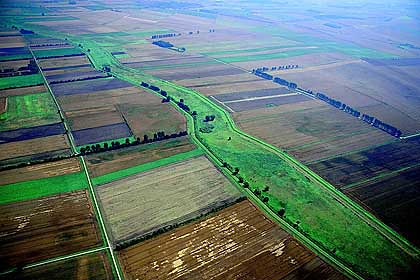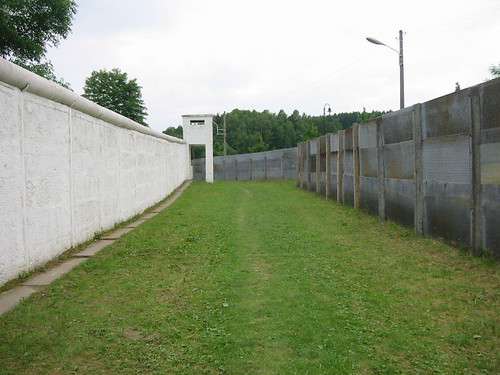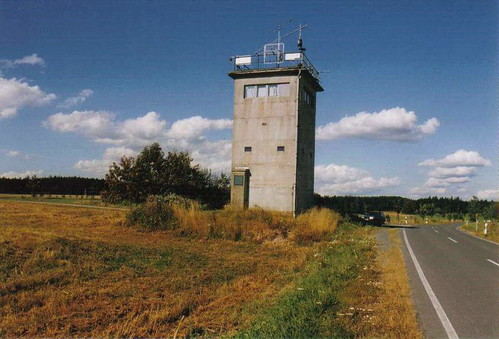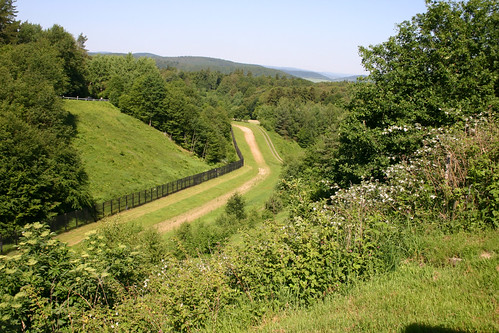where truces and cease fires grow on trees…

[Image: Former 'Inner German Border' Provides Haven for Wildlife, Spiegel, May 13, 2008.]
While the "inner German border” that once divided East and West Germany decades ago, stretching 879 miles from the Baltic Sea to the Czech Republic, was a tangled jungle of barbed wire, landmines, booby traps and soldier patrols, it was also, much like the Korean DMZ, a kind of sanctuary for considerable wildlife.
When the Berlin Wall fell German environmentalists fought to protect the long line of no-man’s-land as a Green Belt, connecting it with Europe’s larger green belt that has followed the path of the Iron Curtain from the north of Finland south to the Adriatic Sea.

[Image: Former 'Inner German Border' Provides Haven for Wildlife, Spiegel, May 13, 2008.]
Up until now the German Green Belt has had very little legal protection, and while it still has a long ways to go, Spiegel reports that the groundwork for a new agreement between the federal Government and the local German states which directly assume responsibility for the Green Belt have reached some form of legal outlines for its protection. Currently, only a third of the natural corridor is designated a nature conservation area, but that could soon be increased. The Green Belt itself though is of great interest.
The no-man's-land that emerged, ranging from 60 to 200 meters wide, provided the ideal conditions for the flourishing of flora and fauna. Up to 600 endangered species, including the black stork and the lady's slipper orchid, thrived in this unusual terrain.
What has made this green corridor remarkable is the interlocking of over 100 types of biotopes, including forests, fens and meadows. Hubert Weiger, president of BUND, told the Süddeutsche Zeitung on Tuesday that "in other places species become extinct because their habitats shrink to islands due urban sprawl." According to Geidezis this is unique in Central Europe. "You don't find these connecting biotopes in Europe any more. Most have been split up, preventing animals from traveling from place to place."

I will leave you to go read about the details of the legal proceedings that aim to protect the Green Belt. I am more curious about what perhaps it could symbolize in a heightened era of protracted border security.
What if somehow in a great show of geopolitical magic all of the border fences, boundary walls and separation barriers that callous the world’s neighborly skin suddenly vanished? Miles of scrappy national security architecture just dissolved in a great disappearing act leaving only trails of dirt behind on its barren stage. And then, over the course of a few years, filling in these tracts of severed farms and semi-conquered wetlands, of annexed soils and halved rural pasturtopias, new post-conflict species of borderzone flora and fauna colored in the rugged footprints with epic flourishes of greenery.
Forgive me for sounding ridiculously hippie dippie here, but imagine the borders of the future bound in bloom instead of barricade; crossings blended by mossy sutures rather than surgical fences and political non-futures.


Suppose these old curvilinear scars of border space could be remade into the world’s longest and narrowest public parks project. Bi-national teams of landscape architects and horticulturalists are organized from both sides of all the old fences. Each region designs its own celestial garden corridor -- a strip garden in a long line of international strip gardens -- that turns the remnant jetties of border conflict into opulent open air greenhouses shared and protected by joint nations. Local cross-border communities would maintain them. Dignitaries from all over the world would hail them as these long lush paths to political healing, while travelers and ecologists would wander down the rolling green carpets siphoning unsmelled fragrances through their nostrils and basking in the Eden like experience of post-militarized botanical reverie. The border grown into the geography of a dispersed global ecological refuge. Stitching nations together with enclaves of freshly oxygenated public space these elongated nature preserves would help to spawn innovative conservation policy, allow new species to emerge, and even old ones to re-emerge. Call them peace parks, green belts, border gardens, whatever, Subtopia will surely be there enjoying an eternal picnic under those canopies where truces and cease fires grow on trees.







3 Comments:
I love the German Green Belt. When my brother came over to Hamburg to visit me (I'm American) we went to the old border to have a look at it.
It's a little sad that the Germans - in their hurry to forget how awful the seperation had been - decided to tear down absolutely every sign of the border crossings. A couple of leftover flak towers would have been fun to climb. Maybe that could be something to consider in your future utopia?
Anyway, my brother - he was born in June of 1989.
So he and I got to walk through an entire birch forest which had sprung up in the former no-man's-land.
Each and every tree was almost exactly his age.
What a wonderful post! It makes such beautiful sense. Personally, as one who has worked to bring about green belts, I would love to see something like this left to become whatever it naturally becomes.
Bund Naturschutz, one of Germany's largest environmental groups. The project was begun in 1989 i think this is one of the most incredible projects ever done, The Bund Naturschutz wants to exert pressure on the Bundesländer to designate several areas as nature reserves and has appealed for donations from the public to enable Bund Naturschutz to acquire properties along the Green Belt. Great post!
Cheers,
Chrissy B,
Post a Comment
<< Home